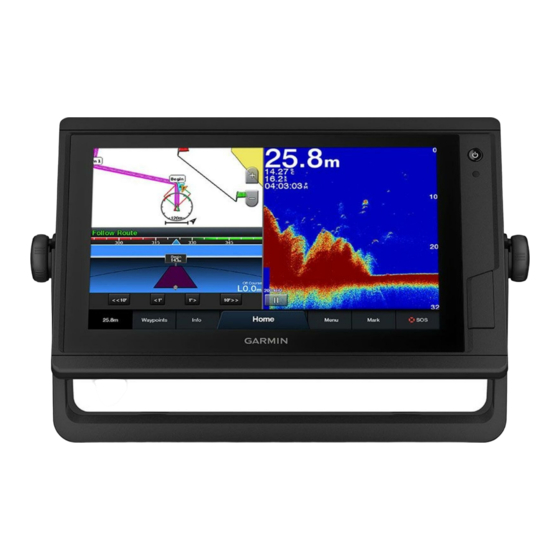Garmin STRIKER PLUS 5 Panduan Pemilik - Halaman 6
Jelajahi secara online atau unduh pdf Panduan Pemilik untuk Peralatan Kelautan Garmin STRIKER PLUS 5. Garmin STRIKER PLUS 5 16 halaman. Compass safe distance
Juga untuk Garmin STRIKER PLUS 5: Panduan Petunjuk Instalasi (16 halaman), Panduan Memulai Cepat (2 halaman)

Left side of the vessel
Right side of the vessel
The transducer on your vessel
Trees
Old tires
Logs
Distance from the side of the vessel
Water between the vessel and the bottom
Split-Screen Frequency
You can view two frequencies from the split frequency screen.
Flasher
The flasher shows sonar information on a circular depth scale,
indicating what is beneath your boat. It is organized as a ring
that starts at the top and progresses clockwise. Depth is
indicated by the scale inside the ring. Sonar information flashes
on the ring when it is received at the depth indicated. The colors
indicate different strengths of the sonar return.
Select Flasher.
Depth at your present location
Depth scale
Split-Zoom View
On the split-zoom page, you can see a full-view graph of sonar
readings on the right side of the screen, and a magnified portion
of that graph on the left side of the screen.
From a sonar screen, select
4
> Zoom > Split Zoom.
Zoomed depth scale
Zoom window
Depth range
Selecting the Transducer Type
If you are connecting a transducer that was not included with the
device, you may need to set the transducer type to make the
sonar function properly. Before connecting the transducer, you
should select the transducer type. The transducer name should
be listed on the label on the transducer cable, near the
connector.
1
Select Settings > My Vessel > Transducer Type.
2
Select an option:
• If you have a 200/77 kHz, dual-beam transducer, select
Dual Beam (200/77 kHz).
• If you have a 200/50 kHz, dual-frequency transducer,
select Dual Frequency (200/50 kHz).
• If you have another type of transducer, select it from the
list.
Sonar Frequencies
NOTE: The frequencies available depend on the chartplotter,
sounder modules, and transducer being used.
Adjusting the frequency helps adapt the sonar for your particular
goals and the present depth of the water.
Higher frequencies use narrow beam widths, and are better for
high-speed operation and rough sea conditions. Bottom
definition and thermocline definition can be better when using a
higher frequency.
Lower frequencies use wider beam widths, which can let the
fisherman see more targets, but could also generate more
surface noise and reduce bottom signal continuity during rough
sea conditions. Wider beam widths generate larger arches for
fish target returns, making them ideal for locating fish. Wider
beam widths also perform better in deep water, because the
lower frequency has better deep water penetration.
CHIRP frequencies allow you to sweep each pulse through a
range of frequencies, resulting in better target separation in
deep water. CHIRP can be used to distinctly identify targets, like
individual fish in a school, and for deep water applications.
CHIRP generally performs better than single frequency
applications. Because some fish targets may show up better
using a fixed frequency, you should consider your goals and
water conditions when using CHIRP frequencies.
Some sonar black boxes and transducers also provide the ability
to customize preset frequencies for each transducer element,
which enables you to change the frequency quickly using the
presets as the water and your goals change.
Sonar Fishfinder
